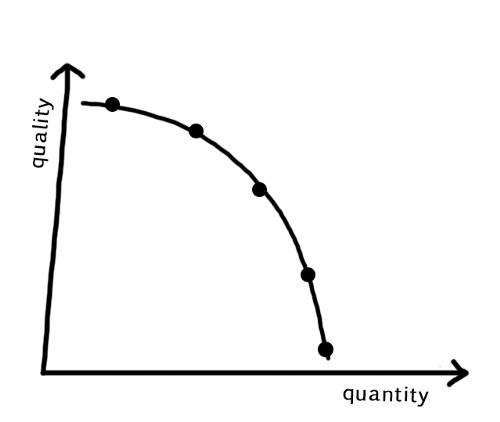All posts by Shraddha Shenoy
The Number Game
When quantity takes precedence over quality
Here’s a thought experiment: Ask a few people to randomly pick between quality and quantity. A surprising majority would pick quality, even in the absence of context. It is an ingrained idea that quality is superior. But is that always true? Sometimes, we might be better off broadening than deepening. Let’s examine.
The more we travel, the more we explore.
The more we read, the more we understand.
The more we fail, the more we learn.
Often times, letting quantity steer the wheel can expose us to a wide range of experiences that would otherwise have been limited to a few.
If efforts are streamlined and directed, the synergic effects can be greater than a few targeted efforts. Take content-creation for instance. Gary Vaynerchuck, entrepreneurship’s poster child and the king of PG-13 keynotes, has been a long-time proponent of voluminous content-generation for creators. Essentially, he says it’s better if creators put out huge amounts of okay-quality content than a small number of high-quality content. I concur for the most part. Primarily because it helps to get the ball rolling, but also because in hiding behind the ‘quality’ wall, one’s overall momentum often slows down. It’s the generation of doers, and with the Internet, speed-to-market is more important than ever.
Further, quantity often helps gather large datasets that aid better decision making. Take dating for instance — dating one person before getting married isn’t nearly enough experience to make a life-altering decision. Barring the few lucky ones that find their soulmates in the first go, plain Janes of the world need to kiss a hundred frogs before finding their prince (figuratively speaking). Having a few in the basket helps draw comparisons, and in the process, determine the best path forward. Just like machines learn through data, humans learn through experiences that can come by way of getting more in the bag, even if that means setting the bar a little lower.
Finally, the evident compounding effects are too obvious to ignore. Take the west’s infatuation with emerging markets in Asia and Africa. While per capita return on investment for most mass consumer brands is substantially lower in comparison to domestic markets, the little droplets add up. And in this scenario, it truly is a number game.
Imagine this – you have 3 bananas and 100 peanuts at home. You need around 500 calories immediately for a moderate day hike. It’s much easier to eat the 3 bananas and get going, so that’s what you do. The next day, you again need 500 calories immediately for a 10K run. You already ate the bananas, so you stop sulking and start eating the peanuts. It takes more effort to eat 100 peanuts and it may feel like it’s not worth it, but you’re an ambitious athlete. Notwithstanding the hassle, you now have the 500 calories you wanted.
That’s what developing countries (the peanuts) and developed countries (the bananas) are to western businesses (you). But you eventually gain 500 + 500 = 1000 calories (the $$$). All’s well that ends well.
The three examples mentioned above are random — which is exactly the point. It can be beneficial to chase numbers and numbers only in any situation, as long as we’re cognizant of the inevitable trade-offs.

As is the case with pretty much everything, balance is key. On the quanti-lity graph, it is imperative that we find a balance and not compromise on our core objectives. If the goal is to have meaningful long-lasting relationships, then it is only apt to be strongly tilted towards quality because achieving quantity would mean compromising the very core objective. Defining where we must stand is personal and has to be an independent quest. But once we know what we aim to achieve, it gets easier to define how to get there.
This article was originally published on Medium.
Feature image source

